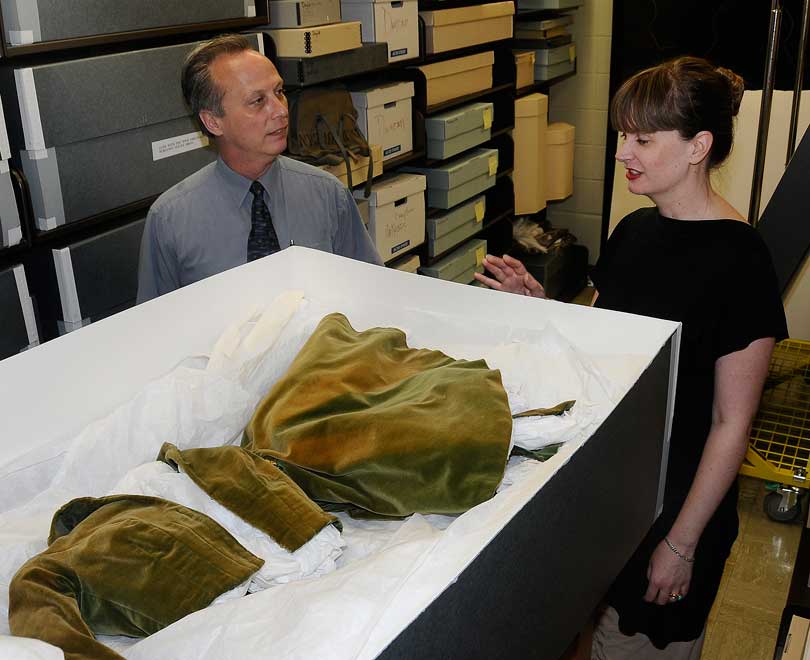
How to Wear and Care for Vintage Fashion
Feb 20, 2024 / Public Storage
Ring in the new year in a vintage gown like a glamorous star of the silver screen, and join celebrities like Julia Roberts and Chloë Sevigny, who are admired for wearing looks from the past on the red carpet. They know no one else will show up in the same thing and that vintage fashion is often made of unique and beautiful materials with quality craftsmanship. Vintage evening wear can often be found for a more affordable price than purchasing new. Guest blogger Jill Morena cares for and exhibits vintage movie costumes as a curator at the Harry Ransom Center at The University of Texas at Austin. She shares her tips below on storing and caring for older garments and what to look for if you decide to wear vintage, whether for every day or a special occasion.
Jill is shown at work below with the original “curtain dress” from Gone With The Wind at the Ransom Center, a library, archive and museum.
Guest post by Jill Morena
The historic clothing and costumes I oversee at work are never worn again once they become a part of our collections. Personally, I have loved wearing vintage since high school, back when it was still called “second hand”;. I like to fill my own closets with pieces that often have minor flaws and a history of known and unknown stories. If you plan to wear vintage for New Year’s—and plan to keep your outfit—there are a few things to keep in mind so that it lasts long after your night out.
Things to Consider Before You Purchase Vintage Fashion
- Pay special attention to fit. Sizes generally were smaller. Armholes were often much higher and smaller, for example, than they are today. Develop an awareness of how high you can raise your arms in the dress.
- Remember that pre-1960’s non-knit clothes have very little give, and zero spandex.
- Polyester from the 1960’s and 1970’s is a heavier weight fabric and will not breathe as easily as the polyesters of today. Keep this in mind for a long night of dancing!
- An authentic Gatsby-era dress is likely made of fragile, 80-year-old silk adorned with heavy beads, making it vulnerable to tearing. You might consider a reproduction instead.
- Take a close look at the threads holding up embellishments such as beads, sequins or feathers. If the threads are disintegrating, try to carefully reinforce them, if you can.
Caring For Vintage Clothes
Few of us have the resources to keep vintage clothing in the low temperature and humidity-controlled environments favored by museums, but there are some ways to store and care for vintage to make it last longer.
- As best you can, store all clothes in a dark, dry space, away from damaging light, humidity, heat and cigarette smoke.
- If the foundation fabric is strong enough, hang your vintage dress with care. Use padded hangers or wrap hangers with acid-free tissue or unbleached muslin to avoid the fabric coming into contact with wood or wire.
- Take special care if you need to clean your gown. Some fabrics such as silks, fine wools or crepes can shrink and distort in water, even with hand washing. Dyes can also bleed into other areas of the garment.
- Dry cleaning can sometimes be too harsh for some old fabrics or embellishments such as paste jewels or old buttons, which can melt. Most dry cleaners will ask you to remove them.
- Do your best to keep out clothes moths, silverfish and carpet beetles, which can eat wool, fur, hair, horn, feathers, cotton and linen.
- Monitor clothes every three to six months, keeping an eye out for small, irregular-shaped holes or insect casings on the fabric.
- Clothes moths are attracted to dirty clothes, which is why it is best to clean at the end of the season. Dry cleaning kills larvae, but may also cause damage to certain fibers.
- If you choose to dry clean, work with a dry cleaner experienced with old garments.
- Cedar does not protect your clothes and could actually damage them. Acids from the wood or extra added cedar oil can eventually transfer to the garment.
- Bias cut dresses should be treated with special care. They have a more flowing fit and are more fragile. Because of the direction of the weave, they can stretch and become misshapen when hung.
- To avoid misshaping on a hanger, consider storing old bias-cut or any heavily embellished dresses flat and unfolded in an acid-free box or a drawer, wrapped in acid-free tissue.
- If you have to fold the garment, support any folds with small rolls of acid-free tissue, to avoid creasing over time.
- If your vintage clothes have a lot of personal value, you can try to work with a textile conservator to help you rehabilitate, clean or preserve them.
Above all, enjoy wearing your vintage find!
Image above: Ransom Center Film Curator Steve Wilson and Jill Morena, Assistant Curator of Costumes and Personal Effects, with the original curtain dress from Gone With The Wind. Photo by Anthony Maddaloni. Image courtesy Harry Ransom Center.
Do you love vintage? Please share your tips or stories below or tell us on Facebook, Pinterest, or Twitter!







